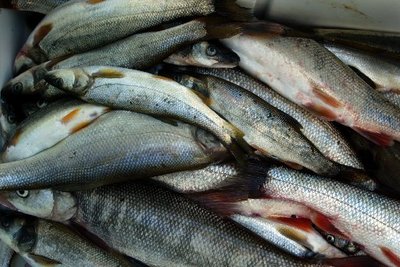forum
library
tutorial
contact

Council Approves Emergency Funds to Cover
Shortfall for Pikeminnow Fishing Rewards Program
by Staff
Columbia Basin Bulletin, September 16, 2016
|
the film forum library tutorial contact |

|
Council Approves Emergency Funds to Cover
by Staff
|
225,000 Fish Caught, Top Angler Earns $119,000
 The Northwest Power and Conservation Council reluctantly approved using Budget Oversight Group (known as BOG) emergency funding for the Bonneville Power Administration's Northern Pikeminnow Sport Reward program, which is already over budget this year with one month remaining in its season.
The Northwest Power and Conservation Council reluctantly approved using Budget Oversight Group (known as BOG) emergency funding for the Bonneville Power Administration's Northern Pikeminnow Sport Reward program, which is already over budget this year with one month remaining in its season.
Pikeminnow program managers -- BPA and the Pacific States Marine Fisheries Commission -- had initially asked BOG for $700,000, but revised the request downward this month as it asked for funding from the Council, which met this week in Spokane, Washington.
According to Council project implementation manager Mark Fritsch, PFMC made its initial request to the BOG oversite group in August as it came to realize it would have a shortfall in angler payments during the 2016 season of the sports reward program.
BOG could not come to a consensus, he said, and Tony Grover, Director of the Council's Fish and Wildlife Division, opposed the emergency funding. However, BPA believed the funding was justified and brought the request to the full Council this week. BPA revised the funding request down to $350,000 in early September, based on an in-season catch data analysis through August 31.
The annual program budget is $1.5 million, but this year, with one month remaining in the program, expenses have already reached $1,487,704.
Council member Bill Booth, Washington, said he'd approve the emergency expenditures but that this is not the way the program should be budgeted and that BOG expenditures are intended for emergencies.
"I'll support this request," he said. "This is a very expensive program overall and this type of program needs to be budgeted and then stick to it."
He suggested notifying anglers that if funds run out before the end of the season, the program will still end. He also suggested that BPA and PSFMC meet with the mid-Columbia River public utility districts to find out why their pikeminnow suppression efforts cost so much less.
"Still, this is one predator control program that doesn't create a lot of controversy," added Henry Lorenzen of Oregon and Council chair.
BPA and the Council formed BOG in 2004 to conduct a budget tracking process, funding BOG with $1 million each fiscal year (October 1 -- September 30). BOG funding was established to provide an opportunity for fisheries project managers to address emergencies and lost opportunities. About $500,000 remains in the BOG account for this fiscal year, which ends September 30.
Dave Roberts, BPA Northern Pikeminnow project manager, told the Council that program costs can be difficult to predict due to some preseason unknowns, such as the number of anglers and how many fish they will catch each year.
The objective of the Northern Pikeminnow Sport Reward program that began in 1991, according to Roberts, is to pay recreational anglers to catch and remove the pikeminnow in order to reduce predation on salmon and steelhead, many of which are listed under the federal Endangered Species Act.
Based on 1983 -- 1986 research in the John Day reservoir, pikeminnow accounted for up to 80 percent of predation on salmonids, he said. The conclusion is that the removal of 10 to 20 percent of predatory size pikeminnow could result in up to a 50 percent reduction in predation.
That exploitation rate is not met every year. With one month left in the season this year, anglers are at 8.4 percent exploitation. Last year's exploitation rate was 17.2 percent; 2014 was 11.5; 10.8 in 2013; 15.9 in 2012; 15.6 in 2011; and 18.8 in 2010. Other than this year that isn't complete, anglers have failed to reach 10 percent in just two years -- 8.1 percent in 1993 and 9.6 percent in 1997.
Angler registration has declined from 6,490 anglers in 2002 to 2,618 in 2013, a number that alarmed the program managers enough to change the pricing structure of payments to anglers in 2015 and step up the amount of marketing for the program. The first tier of pricing for catches up to 25 fish is $4: it was $3. The second tier for catches 26 to 200 is $5, up from $4. The highest tier for catches over 200 remained the same at $8. For tagged fish -- the Oregon Department of Fish and Wildlife tag some pikeminnow each year -- anglers receive $50.
The pricing changes were designed to attract new anglers, Roberts said. The number of anglers in 2014 was 2,773 and that number increased to 3,210 last year.
So far this year, about 205,000 pikeminnow have been caught in the program, more than 2015 at 200,214 fish. The highest tally was in 2004 at 267,414. The lowest was 104,536 in 1993.
The new pricing structure and resulting higher catch and number of anglers are the reasons the program is over budget.
Steve Williams of the PSFMC offered several ideas for controlling costs in future years:
For more information on the emergency BOG request for the Pikeminnow program, see www.nwcouncil.org/media/7150531/9.pdf
Related Pages:
Pikeminnow Sport Reward Program Successful This Year by Staff, Columbia Basin Bulletin, 11/4/16
learn more on topics covered in the film
see the video
read the script
learn the songs
discussion forum
